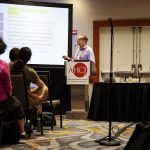By Jordan Gass-Pooré/Freelance Health Journalism Travel Scholarship
Nearly two years after the U.S. Supreme Court overturned Roe v. Wade, pregnant people continue to have difficulty accessing abortion care across the country. During a panel at HJ24, a group of medical professionals discussed the impact of the reversal, including what they’re seeing on the ground.
Abortion, especially during an election year, can be a challenging topic to cover, said Eleanor Klibanoff, The Texas Tribune’s women’s health reporter. But, it’s crucial in a post-Roe America for journalists to focus on abortion as a health issue and center reporting on the experiences of patients and providers impacted by these changes in policy and law, she added.
Some providers may be reluctant to speak openly to journalists due to fear of losing their job, medical license, even their life, said Dr. Kate Arnold, an OBGYN based in Washington, DC.
For Arnold, the consequences of talking with a journalist when she worked at a Federally Qualified Health Center in Oklahoma were greater than she thought.
Personal safety risks
After she gave an interview to a journalist, her employer warned her she couldn’t speak out about her working conditions without prior approval from management.
“I was really frustrated and I said, ‘As Kate Arnold, I can do any interview I want. I just can’t say your name, right?’,” she said. “Eventually, they told me, ‘The FBI has already contacted us. There’s threats of violence against our clinic.’”
The clinic only provided contraception, not abortion care, but the risks eventually got too high so Arnold and her family moved out of Oklahoma in June 2023.
States like New Jersey and New York that continue to allow abortion have seen an influx of patients seeking care.
“We have lots of women that are traveling from states and, therefore, demand has been high for a while,” said Dr. Glenmarie Matthews, director of Complex Family Planning at Rutgers Robert Wood Johnson Medical School.
Matthews said people of color and those who face economic hardship have borne the brunt of abortion restrictions.
“The people that are of lower socioeconomic status are already restricted by the fact that they don’t have the financial means to travel to states that will be able to enable them to get the abortion care that they need,” she said.
Negative health impacts
Limits on abortion access can lead to negative health impacts, said Dr. Dragoman, system director of Complex Family Planning at Mount Sinai Hospital System.
“Legislation cannot predict the circumstances that patients will find themselves in that can impact their health in the short term. And when we’re talking about health, are we talking about lifelong comorbidities or increased risk for problems that will have an impact on the pregnant person’s health and their ability to take care of their current or potential future families?”
All panelists emphasized the importance of incorporating patient stories and experiences in reporters’ coverage of abortion. These real-life stories can help humanize and responsibly represent abortion access challenges.
Jordan Gass-Pooré is an independent podcast producer and investigative journalist based in New York City. Gass-Pooré is the creator, senior producer, reporter, and host of Hazard NJ, a limited-series podcast with NJ Spotlight News about the impacts of climate change on hazardous Superfund sites in New Jersey.





